|
– Part 1 –
After stating in my review of Hammer Volume Three: Blood & Terror box set that it was the last of Indicator’s Hammer collections – albeit with the qualifier ‘for now at least’ – I was rather delighted when the rumoured four box set was officially announced. Having said that, it’s been over a year since the last one was released and you could be forgiven for wondering if this meant that the latest collection would consist of four lesser Hammer titles that didn’t make the grade for earlier box set inclusion. Not on your nelly. There’s not a remotely dud film here, and while just how highly you regard this quartet will depend upon personal taste, there’s no denying that there is some seriously significant and prestige stuff included.
First up, we have the studio’s first legitimate horror sequel, The Revenge of Frankenstein, which also happens to be one of the best films in the Hammer Frankenstein series. Next we have the studio’s first take on a classic tale by Robert Louis Stevenson with The Two Faces of Dr. Jekyll, a work that is perhaps more intriguing for its themes and its sexual daring than its central performance, but that still has a lot to offer for those willing to dig beneath its lovely-looking surface. Then we have Taste of Fear, the first and finest of the studio’s monochrome psychological thrillers and a personal favourite of screenwriter Jimmy Sangster. Finally we have what may be Hammer’s most stylistically unusual film, the Joseph Losey directed science fiction-themed The Damned, a fascinating work that also has a ton of stuff going on beneath its surface.
As ever, and probably even more so than with the previous Hammer box sets, the films are accompanied by an absolute warehouse full of worthy extras. Seriously, if you’re wondering why this review missed its intended deadline, then just sit down and watch every extra here in sequence and write a bit about each when you have any spare time, and I’ll see you again in a few weeks.
| THE REVENGE OF FRANKENSTEIN (1958) |
|
The 1957 The Curse of Frankenstein was a genuine game-changer. It was the first of Hammer’s distinctive takes on the classic Universal monsters, its first full-on horror movie and its first film in colour. Famously, Hammer was forbidden by Universal copyright from using any of the makeup designs and even key narrative elements from the original, which forced the studio to come up with a new take on the story and the look of its creature. The resulting film’s violence outraged the critical fraternity but was adored by the public and made a fortune at the box-office, raking in 70 times its production cost on its first theatrical run alone. Hammer knew they were on to something and quickly followed through with Dracula, another smart and inventive rethink of a Universal classic that was also a massive hit with the public. Even whilst Dracula was in production, the Hammer honchos had twigged that there might be money in turning their first hit into a franchise, and just weeks after shooting on Dracula had been completed, Terence Fisher, the man who had directed both of these standard-setting hits, started work on the studio’s first official horror sequel.
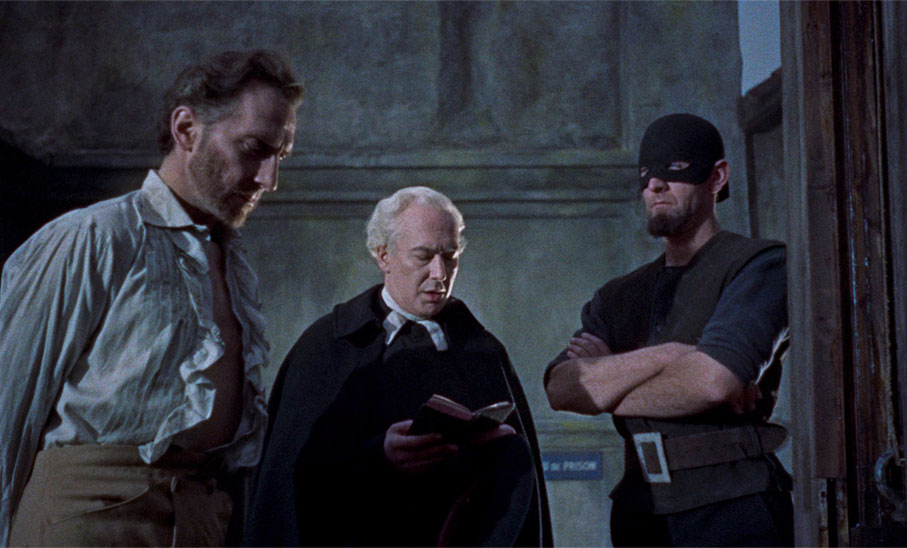
The teasingly titled The Revenge of Frankenstein begins where its predecessor ended with the titular Baron (Peter Cushing) being led to the gallows to be executed for his crimes against God and humanity. Of course, this is just the sort of ending that doesn’t allow for a sequel, and its presence clearly indicates that Hammer had no clue that the first film would catch fire to anything like the degree that it did. And as the sequel begins, the execution appears to go ahead as intended, but the brief shot of a hunchbacked jailer nodding quietly to the executioner, coupled with the camera shying away from the guillotine just before the blade falls is all that’s needed to suggest that the good Baron has somehow cheated death. Well that and a title that proclaims he somehow takes revenge on those he believes have wronged him. You can’t really do that if your head has been separated from your body.
Three years later, a certain Dr. Stein is ruffling feathers with the Medical Council in the town of Carlsbruck, not through acts of malpractice but because he’s so popular with the wealthier locals that he’s stealing all of their best patients from them. Of course, we all know who Stein is even before we catch sight of him (not the best choice of name to go incognito with), he having escaped execution thanks to his hunchbacked assistant Karl (Oscar Quitak), and he now seems to be a reformed man, dividing his time between treating the rampant hypochondria of his rich private patients and his voluntary work at the town’s hospital for the poor. When three members of the Council pay him a visit in an attempt to talk him into joining their cosy club, he cheerily declines and gets back to work. One of them, however, the dapper young Doctor Hans Kleve (Francis Matthews), stays behind to confront Doctor Stein about his true identity, not because he’s looking to expose him but because he wishes to learn from him. Stein (look, that’s the name he chose so that’s what I’m going to call him) seems delighted to have found such an enthusiastic apprentice, and gives him a tour of his secret laboratory, where he has continued his work to create a new living creature from the body parts of others, parts he is harvesting from unnecessary amputations he performs on the poor. He even has a willing donor for the creature’s brain in the shape of the disfigured Karl, for whom the prospect of owning a fully functioning body is an attractive one. What, one wonders, could possibly go wrong?
As it happens, that proves to be a more pertinent question than usual for a series whose central concept seems programmed by tradition to meet with failure. With the intelligent and mild-mannered Karl volunteering his brain, there seems little chance of inadvertently procuring an abby-normal one that will send the resulting creature on a murderous rampage, Kleve proves to be a sincere and dedicated assistant, and the body Stein has built (played by Michael Gwynn) is that of an attractive athlete. And while there are a few initial adjustment hiccups, the operation appears at first glance to have been a success. And you know what? There’s a good chance it would have been were it not for the curse of outsider intervention. Well, that and the well-meaning and enthusiastic Kleve not putting his over-excited brain in gear before thoughtlessly opening his mouth.
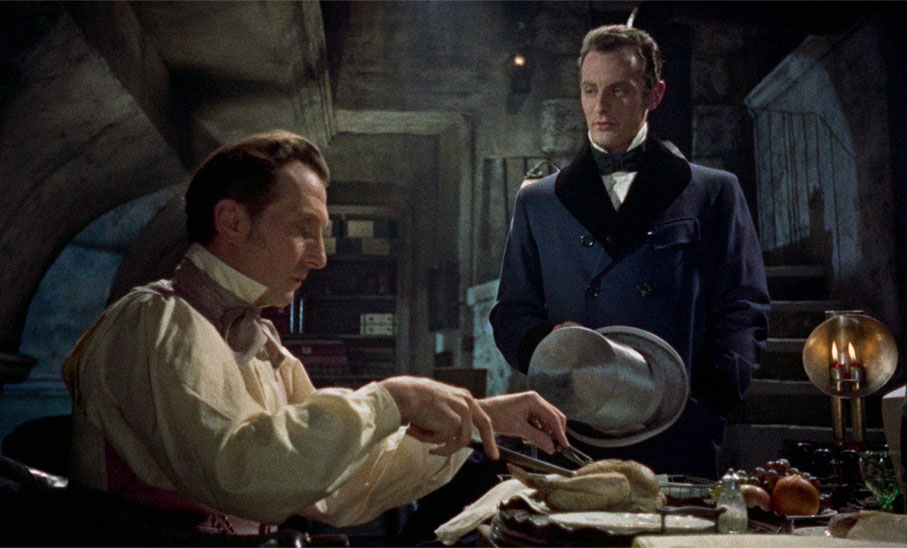
With The Revenge of Frankenstein, Fisher and company give The Curse of Frankenstein the sequel it deserved and for my money it eclipses its celebrated forebear. Jimmy Sangster’s screenplay (with additional dialogue by Hurford Janes and an uncredited George Baxt) is tighter and takes a by-then familiar story into interesting and potentially darker new territory, and director Fisher is really hitting his post-Dracula stride here, particularly in the performances he teases from his actors and the purposeful camera moves and framing of Jack Asher’s moody lighting camerawork. The ever-reliable Peter Cushing has by this point got under the skin of a character whose screen charisma handily deflects attention from his more reprehensible qualities, from his dislike of women to the fact that his surface altruism is a front for what is effectively an organ farm. He’s well matched here by Francis Matthews, who plays Kleve with a conviction that makes him my favourite assistant from the Hammer Frankenstein films, and there’s some nicely understated work from Oscar Quitak as Karl and Michael Gwynn as the creature. Gwynn is particularly good when first coming to terms with his physical transmutation, and his final, desperate plea to his creator (in a sequence that prefigures a memorable scene from the later Frankenstein: The True Story) is the nearest the film comes to a heartbreaking moment. Eunice Gayson (who four years later would find fame as Bond girl Sylvia Trench in Dr. No) does a respectable job as the sorely underwritten token female role of Margaret, a volunteer worker at the hospital whose presence Stein is forced to reluctantly tolerate, and Richard Wordsworth walks a fine line as the rogue who cleans the poor ward and seems to make mischief for no other reason than to amuse himself. The film also marked the first appearance in Hammer’s gothic horror films of studio stalwart Michael Ripper, who is teamed with later actor and director of note Lionel Jeffries as a semi-comic Burke and Hare, whose one scene together is the sort of blackly comic delight that makes me wish they had been more regularly paired.
Some have complained that the film has a bit of a mid-story lull, and while I can see where they’re coming from, there’s a thoughtful humanity to this section in its focus on the creature that for me justifies the temporary change of pace. It also ultimately pays off by building to what would normally be the finale of a Frankenstein film, but which instead triggers off a chain of events that delivers the best ending of any of the films in the Hammer Frankenstein series, one that paves the way for a potentially fascinating follow-up, a London-set story that sadly never saw the light of day.
A handsome 1.66:1 transfer, with a vibrant reproduction of the film’s typically (for the period) warm colour palette and a nicely pitched contrast range that doesn’t sacrifice any of its crisply rendered detail to nail the black levels. A fine film grain is visible and there’s not a dust spot to be seen. Nice.
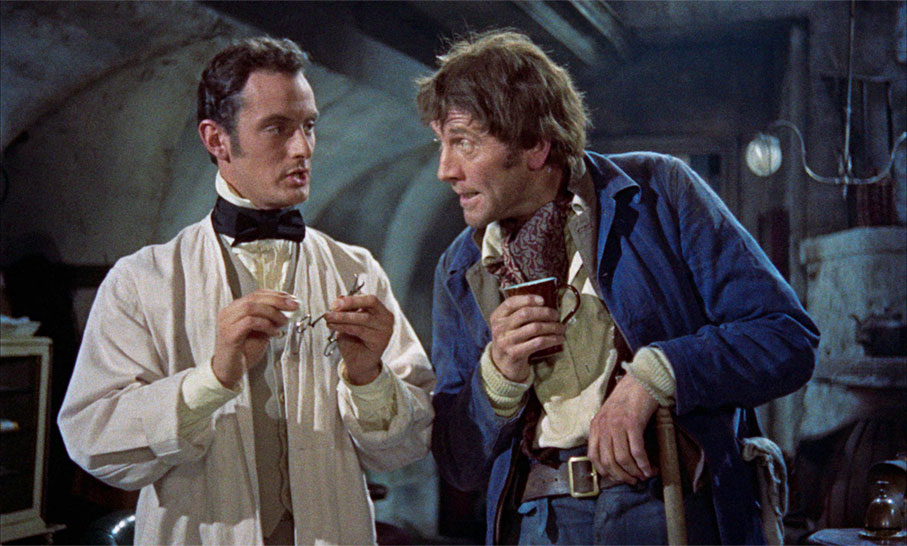
The Linear PCM 1.0 mono track has some audible dynamic range restrictions, with the resulting treble bias more evident on the dialogue than the music. Otherwise it’s in good shape, with no trace of damage or background hiss.
Optional English subtitles are available for the deaf and hearing impaired.
Audio Commentary with Marcus Hearn and Jonathan Rigby
The first of two commentary tracks on this disc features head of archive and library at Hammer Films, Marcus Hearne, and English Gothic author, Jonathan Rigby, and it’s an absolute belter. Hearn and Rigby not only know a huge amount about this movie, they also intimately know their way around Hammer’s entire horror filmography, so are able to contextualise the film, the characters, the themes and even the sets in relation to the studio’s other gothic horror works. There’s so much ground covered here, with a slew of information provided on the movie itself and those involved in its making; the plot points clarified by subsequent novelisations; elements that the BBFC were upset by and changes they enforced to the screenplay; speculation on a line of dialogue that may or may not be an in-joke; the lead actors and the supporting cast; the black humour; the weak nature of the underdeveloped Eunice Gayson role; and a whole lot more.
Audio Commentary with Stephen Jones and Kim Newman
Having gleaned so much information from the previous commentary, I went in to the second one, which features the horror dream team of writer and editor Stephen Jones and novelist and critic Kim Newman, fully expecting it to cover much of the same ground. Wrong! Astonishingly, there’s precious little overlap here, and where the two commentaries do find themselves in similar territory (discussion on actors, characters, scenes and themes), the perspectives almost always differ enough for the comments here to feel fresh. Both men are huge fans of the film and I found myself sharing their views on it even more closely than with those of Hearne and Rigby. What also surprised me is that they make a few observations about the film that Hearne and Rigby missed, but given that there are no pauses in either commentary, neither party would likely have had time to cover every possible aspect. Combined, however, they must come pretty damned close. Superb.
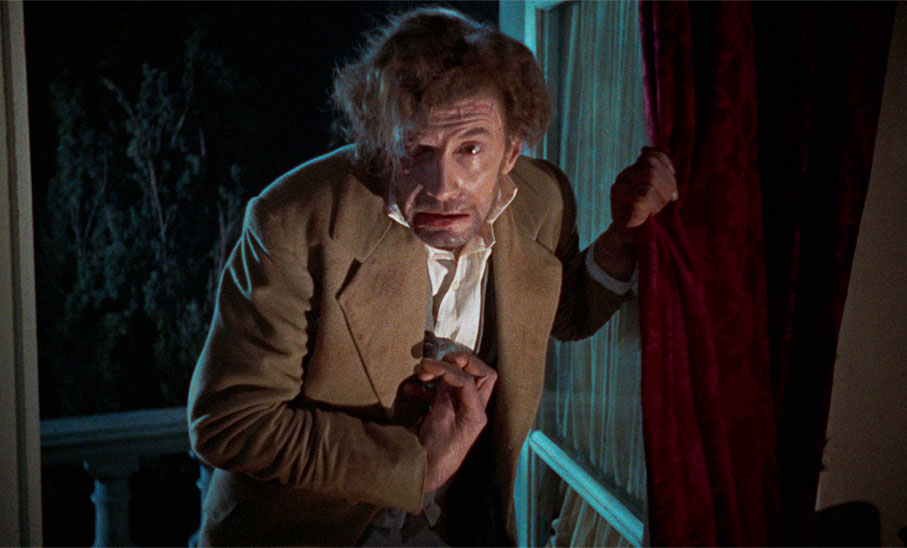
Back From the Dead: Inside The Revenge of Frankenstein (21:21)
The first of four similarly styled featurettes on the films in this set produced and directed by Marcus Hearn, about which I have slightly mixed feelings. This first one is built around interviews with co-author of The Hammer Story Alan Barnes, editor of EOFFTV.com Kevin Lyons, and author of English Gothic Jonathan Rigby, which are intercut with film clips, posters and publicity stills. It provides a concise overview of the making and qualities of The Revenge of Frankenstein, though there is little if anything here that isn’t covered in more detail by the commentary tracks, one of which features the director of this featurette and one of its contributors. That’s not an issue. No, my problem is with the manner in which some of it is presented, and buckle up because I’m about to go on a bit of a rant.
Back in the early years of this still relatively new century, a really tiresome habit emerged that saw interviews shot from two often similarly framed angles that were cut randomly back-and-forth between. The worst examples of this would see one of these angles desaturated of colour or have some other bullshit visual effect applied from the digital toybox that editors now had at their disposal. It grew out of some claptrap belief that a modern audience was somehow incapable of focussing on what anyone was saying for more than a few seconds unless you varied the visuals in some way. This nonsense proved particularly popular with the makers of interview-led special features for certain DVD labels – Hong Kong Legends, I’m looking daggers at you – and I was so, so relieved when all this claptrap was abandoned and we went back to being able to just watch and listen to the person talking without having to tolerate the filmmakers metaphorically waggling their hands in front of the bloody camera. Now I’m not claiming for a second that any of the featurettes here are as bad as Hong Kong Legends extras were at their worst, but for the first time in years I was presented with interviews shot with two cameras, one positioned just a couple of feet away from the other but often similarly framed (though sometimes designed to look a little ‘off’), shots that are then jump-cut between with what feels like random abandon, sometimes even midway through a sentence, edits that serve no purpose except to draw attention to their existence. This, coupled with the occasional burst of rapid ping-pong cutting between an interviewee and a photograph or poster that’s been subjected to a speedy Ken Burns zoom, proved over time to be so visually irritating that I ended up looking away from the screen and just listening to the soundtrack, which is absolutely fine. I have no doubt at all that others will have no issue with this (if you prefer it, then good luck watching the two-hour Jimmy Sangster interview on the Taste of Fear disc, which was all captured in a single and mercifully tic-free shot), but if this is the new Indicator house style, I can see me just listening to future special features that I once happy to watch. That’s it. Finished. I’ll go back to the growlery.
Hammer’s Women: Eunice Gayson (7:05)
Film critic Pamela Hutchinson provides a useful overview of the life and career of actor Eunice Gayson and highlights some of her key films, with particular emphasis on her roles as Margaret in The Revenge of Frankenstein and Sylvia Trench in Dr. No.
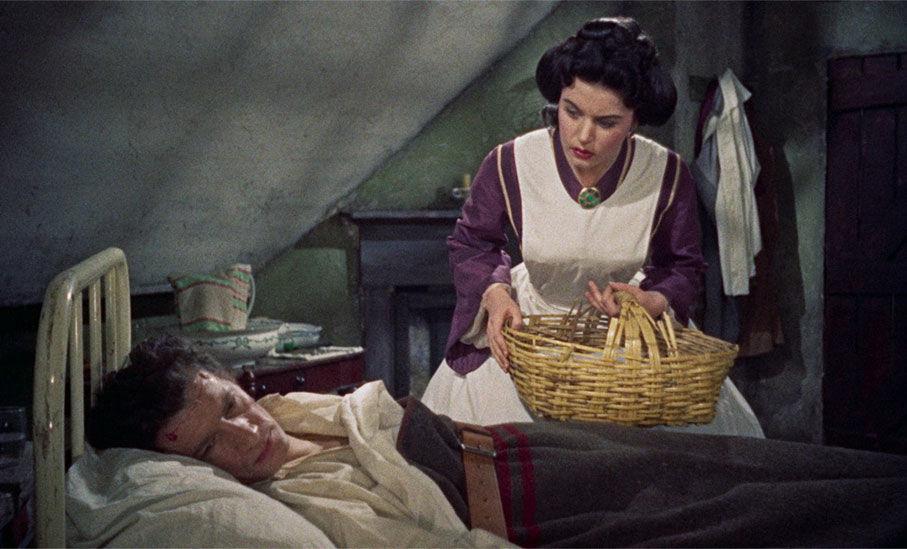
A Frankenstein for the 20th Century (26:37)
If there’s one person I could imagine having enough new observations and information to justify a third commentary track, it would be Kat Ellinger, so imagine my delight when I discovered that this documentary was written and narrated by her for Diabolique Films, which she runs with Dima Ballin, if I’m not mistaken. As predicted, she brings something new to the table, finding connections between Cushing’s Frankenstein and the Dennis Price’s Louis D'Ascoyne in Kind Hearts and Coronets, suggesting that this film has one foot each in the worlds of Jane Austen and Charles Dickens, and exploring the notion of Frankenstein as an antihero. There is a really well argued look at the appeal of the film’s deeper meanings, and I loved Ellinger’s description of it as one that “revels in the charms of the psychopath.”
Arpeggios of Melancholy (12:57)
An always welcome contribution from author and film music authority David Huckvale in which he looks briefly at the career of composer Leonard Salzedo and deconstructs elements of his score. For this musically talentless individual (I’m talking about me) this proved very educational, and I have to admit to being old enough to experience a nostalgic pang when Huckvale plays the Salzedo tune that became the theme for the Open University.
Outtakes Reel (11:43)
A rare and surprising find for a film of this vintage, and while the footage is silent and there are no big revelations, this is still of real interest. Includes some clappers and held-up grayscale charts, which are used for later colour balancing.
Super 8 Version (8:17)
I’m starting to wonder if someone at Indicator has a whole cupboard of these cut-down 8mm versions of the film (I know fellow reviewer Camus has a few in storage). This one’s in black-and-white and silent, so the missing plot details are outlined by captions and dialogue is subtitled, which due to the condition of the print you’ll need to really focus hard to read. Is it just me, or does presenting the film as a badly scratched, 4:3-framed black-and-white print with no sound and a fuzzy image make it look like the cutting copy of a film school project?
Theatrical Trailer (2:17)
A specially shot trailer in which Cushing directly addresses the audience as the good Baron and which includes extracts from the finale of The Curse of Frankenstein. It also has a narrator whose delivery seems to be heading towards hysteria and warnings about the content splashed across the screen in big angular yellow letters.
Joe Dante Trailer Commentary (1:59)
Joe Dante introduces the above trailer and talks about the film and its predecessor and how scary they were to him as a kid. Curiously, even with the introduction this is somehow shorter than the trailer on its own. I’ve not had time to compare the two side-by-side yet to see if anything is missing.
Image Gallery
A humungous 107 screens of production photos, press book pages and posters.
Booklet
After the main credits, we have an essay on the film and its production and the Hammer-Columbia partnership by Marcus Hearne, following which there is an intriguing essay on its production and Hammer’s long-term plans for its lead character by Dr Kieran Foster. Up next is an extract from Jimmy Sangster’s memoir, Inside Hammer, in which he looks back at the writing of what was originally titled ‘The Blood of Frankenstein’. Suggestions for promoting the film from the press book are followed by extracts from contemporary reviews, two of which are more positive than expected.
next >
The Two Faces of Dr. Jekyll | Taste of Fear | The Damned
|